Hyundai Ioniq Electric 2019 Owner's Manual - RHD (UK, Australia)
Manufacturer: HYUNDAI, Model Year: 2019, Model line: Ioniq Electric, Model: Hyundai Ioniq Electric 2019Pages: 526, PDF Size: 16.63 MB
Page 441 of 526
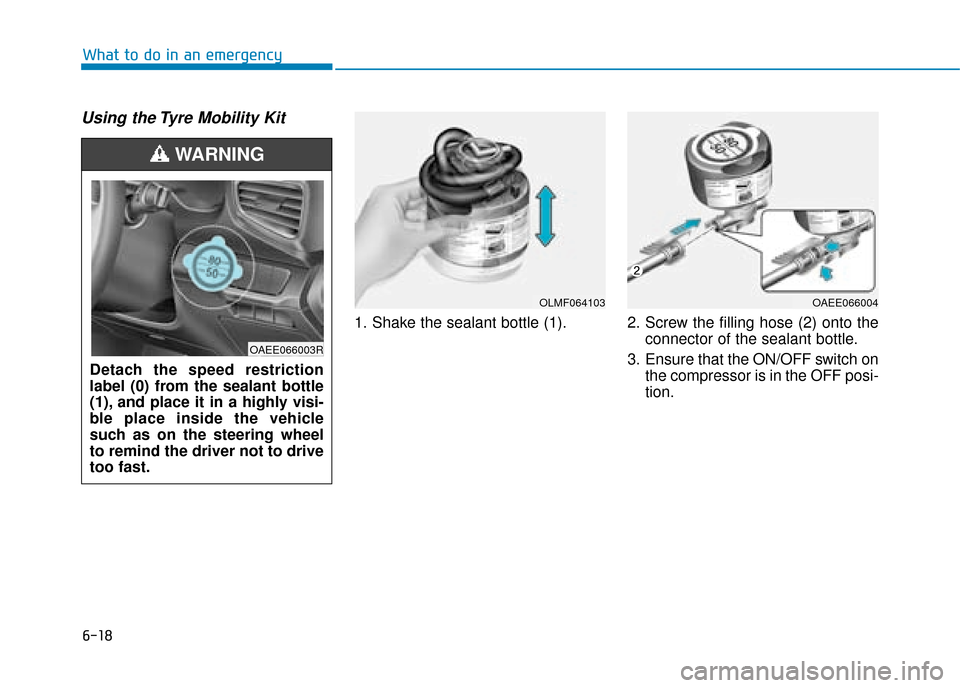
6-18
What to do in an emergency
Using the Tyre Mobility Kit
1. Shake the sealant bottle (1). 2. Screw the filling hose (2) onto theconnector of the sealant bottle.
3. Ensure that the ON/OFF switch on the compressor is in the OFF posi-
tion.
Detach the speed restriction
label (0) from the sealant bottle
(1), and place it in a highly visi-
ble place inside the vehicle
such as on the steering wheel
to remind the driver not to drive
too fast.
WARNING
OLMF064103
OAEE066003R
OAEE066004
Page 442 of 526
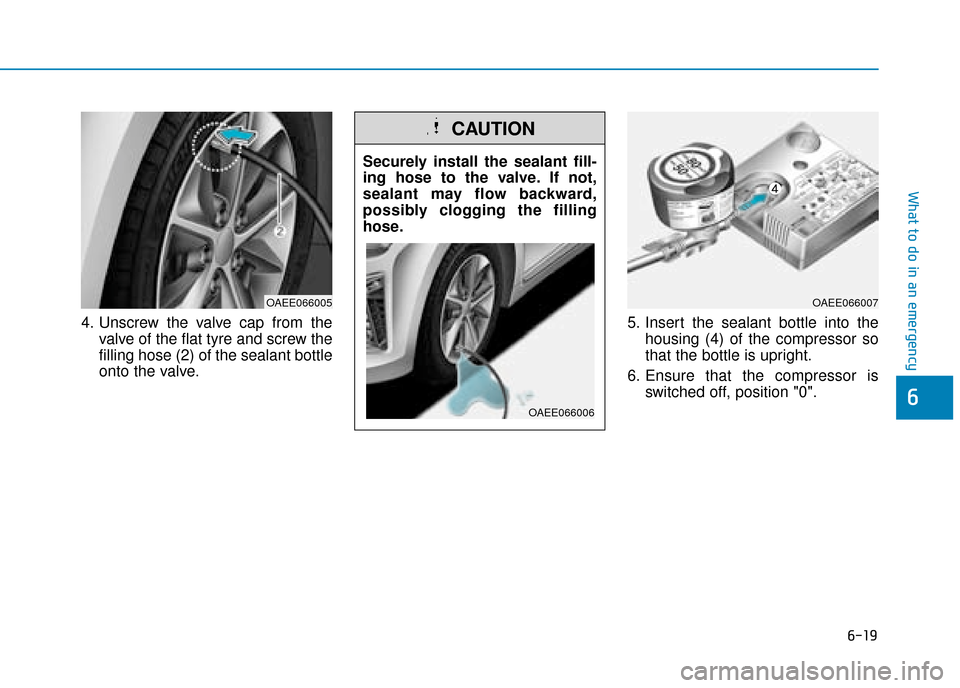
6-19
What to do in an emergency
6
4. Unscrew the valve cap from thevalve of the flat tyre and screw the
filling hose (2) of the sealant bottle
onto the valve. 5. Insert the sealant bottle into the
housing (4) of the compressor so
that the bottle is upright.
6. Ensure that the compressor is switched off, position "0".
Securely install the sealant fill-
ing hose to the valve. If not,
sealant may flow backward,
possibly clogging the filling
hose.
CAUTION
OAEE066006
OAEE066005OAEE066007
Page 443 of 526
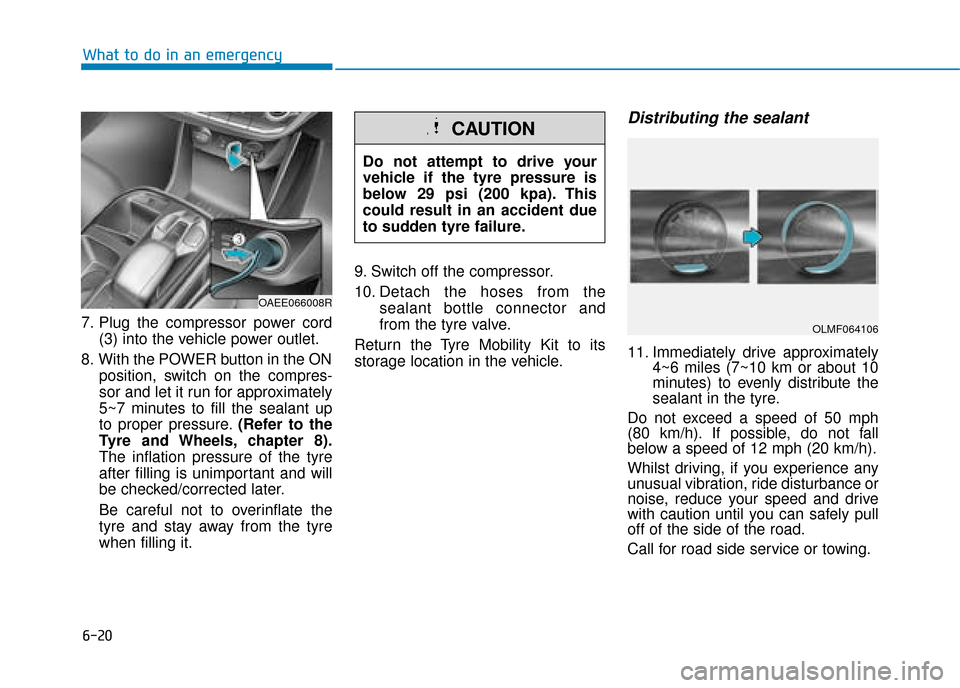
6-20
What to do in an emergency
7. Plug the compressor power cord (3) into the vehicle power outlet.
8. With the POWER button in the ON position, switch on the compres-
sor and let it run for approximately
5~7 minutes to fill the sealant up
to proper pressure. (Refer to the
Tyre and Wheels, chapter 8).
The inflation pressure of the tyre
after filling is unimportant and will
be checked/corrected later.
Be careful not to overinflate the
tyre and stay away from the tyre
when filling it. 9. Switch off the compressor.
10. Detach the hoses from the
sealant bottle connector and
from the tyre valve.
Return the Tyre Mobility Kit to its
storage location in the vehicle.
Distributing the sealant
11. Immediately drive approximately 4~6 miles (7~10 km or about 10
minutes) to evenly distribute the
sealant in the tyre.
Do not exceed a speed of 50 mph
(80 km/h). If possible, do not fall
below a speed of 12 mph (20 km/h).
Whilst driving, if you experience any
unusual vibration, ride disturbance or
noise, reduce your speed and drive
with caution until you can safely pull
off of the side of the road.
Call for road side service or towing.
Do not attempt to drive your
vehicle if the tyre pressure is
below 29 psi (200 kpa). This
could result in an accident due
to sudden tyre failure.
CAUTION
OAEE066008R
OLMF064106
Page 444 of 526
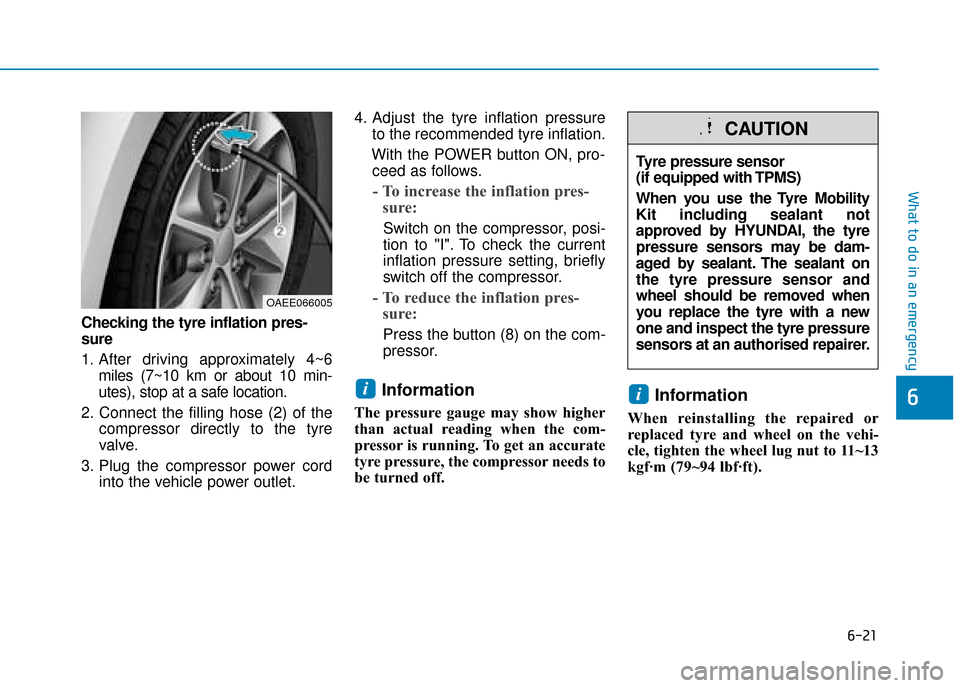
6-21
What to do in an emergency
6
Checking the tyre inflation pres-
sure
1. After driving approximately 4~6miles (7~10 km or about 10 min-
utes), stop at a safe location.
2. Connect the filling hose (2) of the compressor directly to the tyre
valve.
3. Plug the compressor power cord into the vehicle power outlet. 4. Adjust the tyre inflation pressure
to the recommended tyre inflation.
With the POWER button ON, pro- ceed as follows.
- To increase the inflation pres- sure:
Switch on the compressor, posi-
tion to "I". To check the current
inflation pressure setting, briefly
switch off the compressor.
- To reduce the inflation pres- sure:
Press the button (8) on the com-
pressor.
Information
The pressure gauge may show higher
than actual reading when the com-
pressor is running. To get an accurate
tyre pressure, the compressor needs to
be turned off.
Information
When reinstalling the repaired or
replaced tyre and wheel on the vehi-
cle, tighten the wheel lug nut to 11~13
kgf·m (79~94 lbf·ft).
ii
OAEE066005
Tyre pressure sensor
(if equipped with TPMS)
When you use the Tyre Mobility
Kit including sealant not
approved by HYUNDAI, the tyre
pressure sensors may be dam-
aged by sealant. The sealant on
the tyre pressure sensor and
wheel should be removed when
you replace the tyre with a new
one and inspect the tyre pressure
sensors at an authorised repairer.
CAUTION
Page 445 of 526
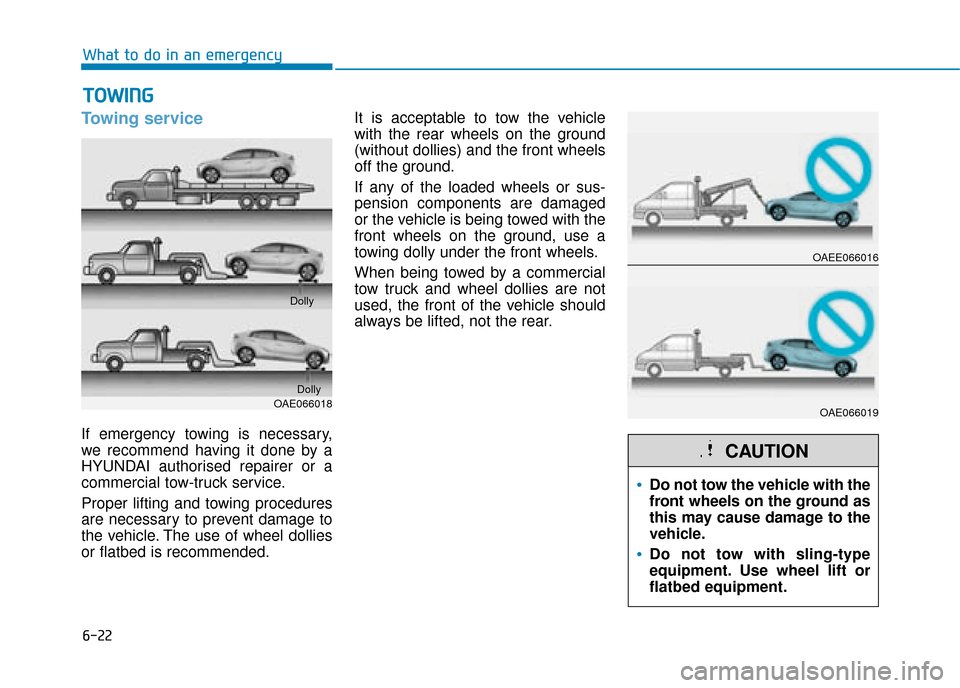
6-22
What to do in an emergency
Towing service
If emergency towing is necessary,
we recommend having it done by a
HYUNDAI authorised repairer or a
commercial tow-truck service.
Proper lifting and towing procedures
are necessary to prevent damage to
the vehicle. The use of wheel dollies
or flatbed is recommended.It is acceptable to tow the vehicle
with the rear wheels on the ground
(without dollies) and the front wheels
off the ground.
If any of the loaded wheels or sus-
pension components are damaged
or the vehicle is being towed with the
front wheels on the ground, use a
towing dolly under the front wheels.
When being towed by a commercial
tow truck and wheel dollies are not
used, the front of the vehicle should
always be lifted, not the rear.
T T
O
O W
W I
IN
N G
G
OAE066018 Dolly
Dolly
Do not tow the vehicle with the
front wheels on the ground as
this may cause damage to the
vehicle.
Do not tow with sling-type
equipment. Use wheel lift or
flatbed equipment.
CAUTION
OAEE066016
OAE066019
Page 446 of 526
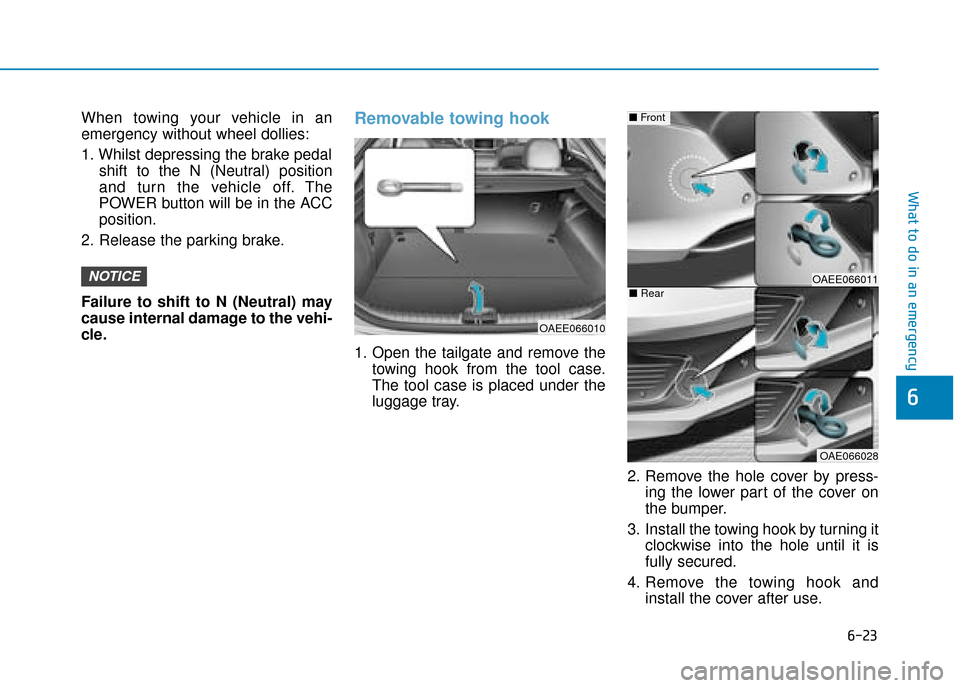
6-23
What to do in an emergency
6
When towing your vehicle in an
emergency without wheel dollies:
1. Whilst depressing the brake pedalshift to the N (Neutral) position
and turn the vehicle off. The
POWER button will be in the ACC
position.
2. Release the parking brake.
Failure to shift to N (Neutral) may
cause internal damage to the vehi-
cle.Removable towing hook
1. Open the tailgate and remove the towing hook from the tool case.
The tool case is placed under the
luggage tray.
2. Remove the hole cover by press-ing the lower part of the cover on
the bumper.
3. Install the towing hook by turning it clockwise into the hole until it is
fully secured.
4. Remove the towing hook and install the cover after use.
NOTICE
OAEE066010
OAEE066011
OAE066028
■Front
■Rear
Page 447 of 526
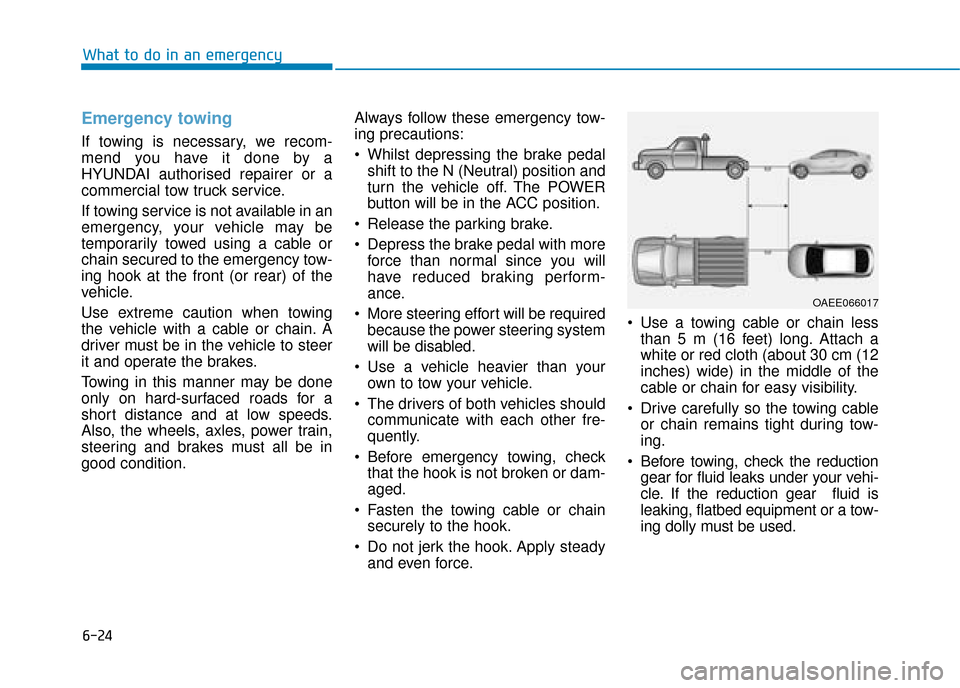
6-24
What to do in an emergency
Emergency towing
If towing is necessary, we recom-
mend you have it done by a
HYUNDAI authorised repairer or a
commercial tow truck service.
If towing service is not available in an
emergency, your vehicle may be
temporarily towed using a cable or
chain secured to the emergency tow-
ing hook at the front (or rear) of the
vehicle.
Use extreme caution when towing
the vehicle with a cable or chain. A
driver must be in the vehicle to steer
it and operate the brakes.
Towing in this manner may be done
only on hard-surfaced roads for a
short distance and at low speeds.
Also, the wheels, axles, power train,
steering and brakes must all be in
good condition.Always follow these emergency tow-
ing precautions:
Whilst depressing the brake pedal
shift to the N (Neutral) position and
turn the vehicle off. The POWER
button will be in the ACC position.
Release the parking brake.
Depress the brake pedal with more force than normal since you will
have reduced braking perform-
ance.
More steering effort will be required because the power steering system
will be disabled.
Use a vehicle heavier than your own to tow your vehicle.
The drivers of both vehicles should communicate with each other fre-
quently.
Before emergency towing, check that the hook is not broken or dam-
aged.
Fasten the towing cable or chain securely to the hook.
Do not jerk the hook. Apply steady and even force. Use a towing cable or chain less
than 5 m (16 feet) long. Attach a
white or red cloth (about 30 cm (12
inches) wide) in the middle of the
cable or chain for easy visibility.
Drive carefully so the towing cable or chain remains tight during tow-
ing.
Before towing, check the reduction gear for fluid leaks under your vehi-
cle. If the reduction gear fluid is
leaking, flatbed equipment or a tow-
ing dolly must be used.
OAEE066017
Page 448 of 526
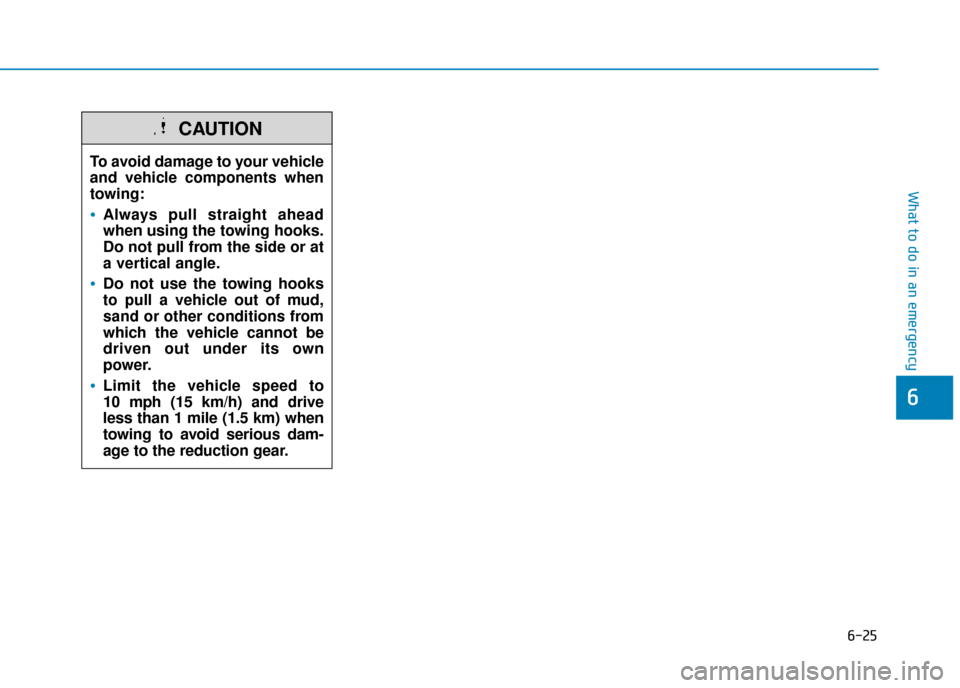
6-25
What to do in an emergency
6
To avoid damage to your vehicle
and vehicle components when
towing:
Always pull straight ahead
when using the towing hooks.
Do not pull from the side or at
a vertical angle.
Do not use the towing hooks
to pull a vehicle out of mud,
sand or other conditions from
which the vehicle cannot be
driven out under its own
power.
Limit the vehicle speed to
10 mph (15 km/h) and drive
less than 1 mile (1.5 km) when
towing to avoid serious dam-
age to the reduction gear.
CAUTION
Page 449 of 526

7
Maintenance
7
Maintenance
Motor compartment...............................................7-3
Maintenance services ...........................................7-4
Owner's responsibility ......................................................7-4
Owner maintenance precautions ..................................7-4
Owner maintenance ...............................................7-5
Owner maintenance schedule ........................................7-5
Scheduled maintenance services.........................7-7
Explanation of scheduled maintenance items ...7-8
Cooling system ...................................................................7-8
Coolant ........................................................................\
.........7-8
Reduction gear fluid .........................................................7-8
Brake hoses and lines ......................................................7-8
Brake fluid ........................................................................\
.7-8
Parking brake .....................................................................7-8\
Brake discs, pads, calipers and rotors .........................7-8
Suspension mounting bolts ...........................................7-8
Steering gear box, linkage & boots/
lower arm ball joint...........................................................7-8
Drive shafts and boots ....................................................7-8
Air conditioning refrigerant............................................7-8
Coolant.....................................................................7-9\
Checking the coolant level..............................................7-9
Changing coolant........................................................\
.....7-12
Brake fluid ............................................................7-13
Checking the brake fluid level .....................................7-13
Washer fluid .........................................................7-14
Checking the washer fluid level ..................................7-14
Climate control air filter .....................................7-15
Filter inspection ...............................................................7-15
Wiper blades .........................................................7-17
Blade inspection ..............................................................7-17
Blade replacement ..........................................................7-17
Battery (12 Volt) ..................................................7-19
For best battery service................................................7-20
Battery capacity label ....................................................7-20
Battery recharging .........................................................7-21
Reset features .................................................................7-22
7
Page 450 of 526
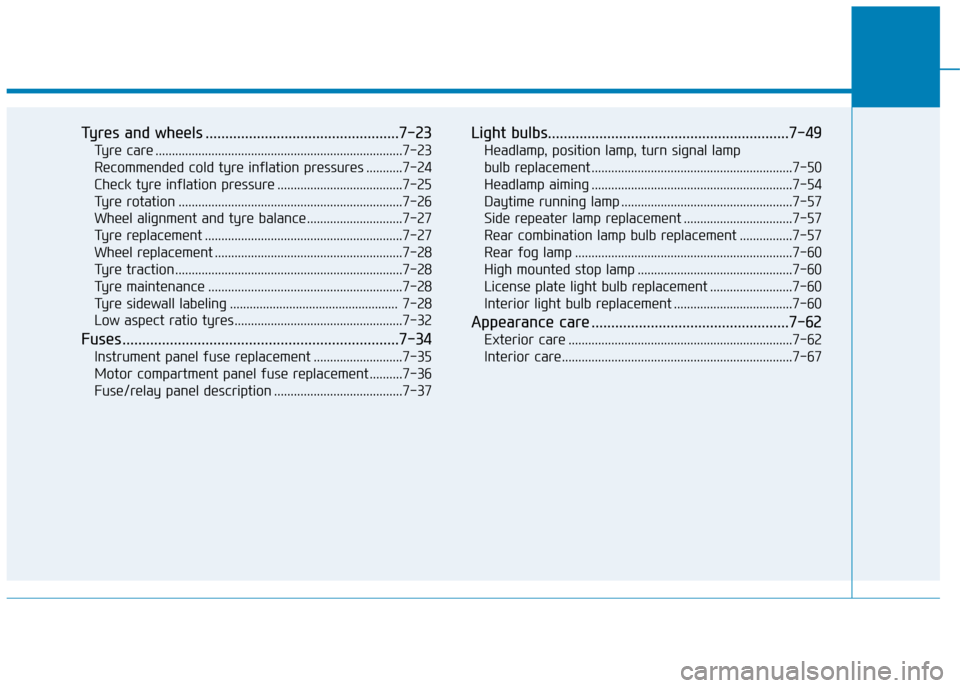
Tyres and wheels .................................................7-23
Tyre care ........................................................................\
...7-23
Recommended cold tyre inflation pressures ...........7-24
Check tyre inflation pressure ......................................7-25
Tyre rotation ....................................................................7-26\
Wheel alignment and tyre balance.............................7-27
Tyre replacement ............................................................7-27
Wheel replacement .........................................................7-28
Tyre traction .....................................................................7-2\
8
Tyre maintenance ...........................................................7-28
Tyre sidewall labeling ................................................... 7-28
Low aspect ratio tyres...................................................7-32
Fuses ......................................................................7-\
34
Instrument panel fuse replacement ...........................7-35
Motor compartment panel fuse replacement ..........7-36
Fuse/relay panel description .......................................7-37
Light bulbs.............................................................7-49
Headlamp, position lamp, turn signal lamp
bulb replacement .............................................................7-50
Headlamp aiming .............................................................7-54
Daytime running lamp ....................................................7-57
Side repeater lamp replacement .................................7-57
Rear combination lamp bulb replacement ................7-57
Rear fog lamp ..................................................................7-60
High mounted stop lamp ...............................................7-60
License plate light bulb replacement .........................7-60
Interior light bulb replacement ....................................7-60
Appearance care ..................................................7-62
Exterior care ....................................................................7-62\
Interior care......................................................................7-\
67